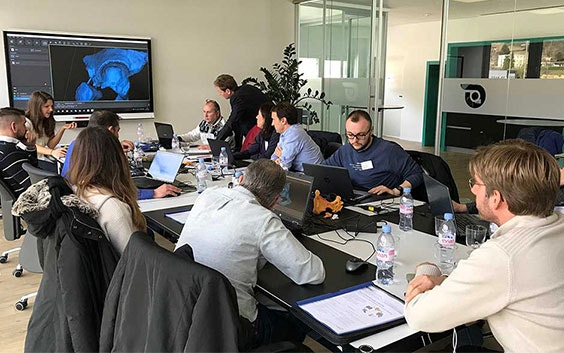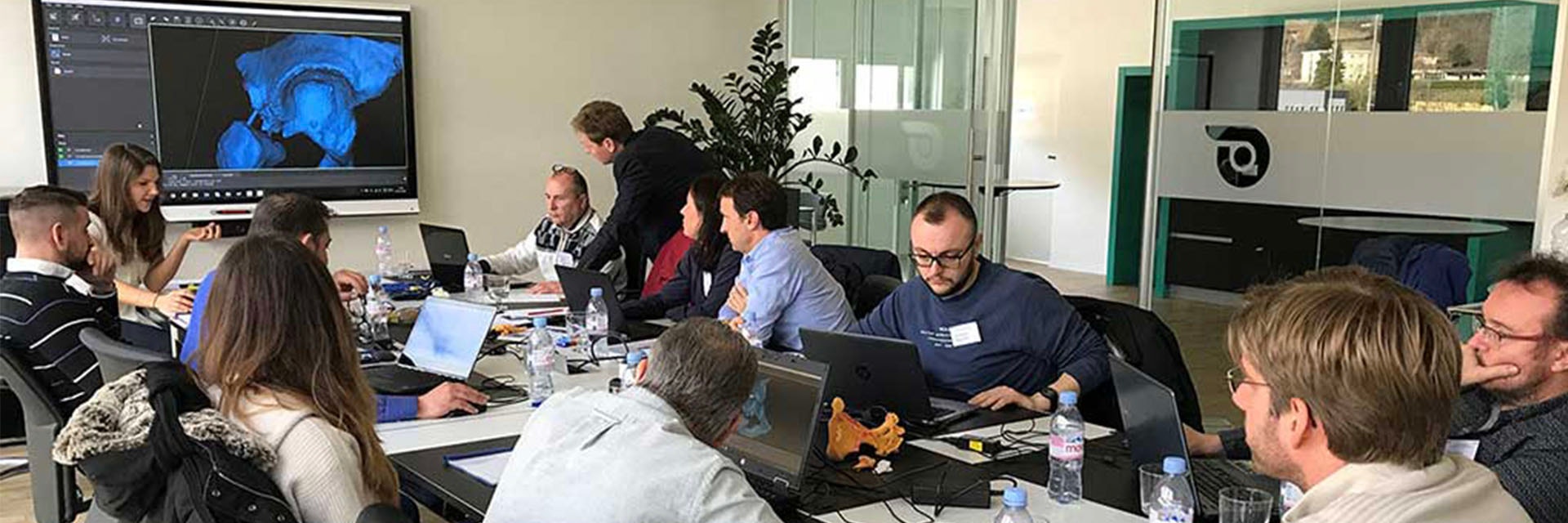CUSTOMER STORY
First Course in Additive Manufacturing in Medicine in Canton Ticino

The first Additive Manufacturing in Medicine course in Switzerland took place in the Italian-speaking region Canton Ticino, highlighting several aspects of 3D printing technology in patient care. The course was made possible through the collaboration of the Swiss company GTK Timek Group SA, a plastics, rubber and polymer manufacturer which opened last year a 3D Medical division, Dr. Nicola Bizzotto, an orthopedic and trauma surgeon at the private Clinic Dolomiti Sportclinic in Bolzano, Italy, and Materialise. Materialise participated in the event by introducing how hospitals can integrate image-based planning into their patient care.
Sharing 3D printing knowledge
Representatives from five medical centers attended the event that included presentations from physicians and industry experts. In addition, there was a hands-on session in which participants could experience Materialise’s 3D printing software Mimics inPrint. The course, also intended as a network meeting for medical professionals, was comprised of sessions about 3D printing applications, the clinical value of 3D-printed anatomical models, and the best practices of implementing 3D printing in a hospital environment.
Part I - What did the participants learn?
The day began with a presentation from Dr. Nicola Bizzotto, in which he shared his experiences with 3D anatomical models of complex fractured bones. As an early adopter of 3D printing technology, Dr. Bizzotto has already implemented 3D printing in his clinic.
Dr. Mattia Ferrazzini, Head of 3D-Medical Division from GTK, followed with a more technical presentation about different 3D printing technologies used in medicine, and the advantages and disadvantages of each. He further explained the applications of 3D printing in the medical field and illustrated some of the frequent difficulties encountered when printing 3D files generated by CT scans.
Next, came an interactive workshop with Carina Wiederer, an application engineer from Materialise. She demonstrated how to work with Mimics inPrint, Materialise’s solution for image-based planning, and how they can use it to integrate medical 3D printing in hospitals. Each workshop participant got the opportunity to learn how to create a 3D anatomical model of a hip fracture, in five steps. Everyone also received a one-month trial of Mimics inPrint, to have the chance to integrate it into their workflow, using their own datasets, in their hospital.


Part II – How to apply 3D printing in practice?
During the second part of the course, Dr. Ferrazzini, Dr. Bizzotto, and Materialise visited each of the five participating medical centers. At each location, they went through some of their cases and their relevant data and explained how the segmentation and preparation of a printable model would work. As a final and tangible outcome, each center could select one case for which they received an actual 3D-printed model made by GTK.
Course takeaways
The main goal of the course was for each participant to understand the main aspects of 3D printing for clinical cases:
- Additive manufacturing processes, printing technologies, and their applications in medicine;
- Why and when a 3D-printed model is necessary for a case;
- Key elements for a CT scan optimized for printing 3D anatomical model;
- How to use the software to make a 3D printed model, all the way from a scanned image to a physical anatomical model.
A course is a wonderful way to start learning about 3D printing in medicine, and an important step forward in exploring its financial, educational, and clinical benefits. Improved communication with patients, clearer visualization of complex anatomies, better surgical planning, and more beneficial patient-specific outcomes. Each can become a reality when you start including medical 3D printing in your practice.
This event is meant only for medical professionals working in hospitals.
Share on:
You might also like
Never miss a story like this. Get curated content delivered straight to your inbox.
